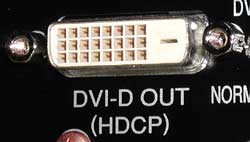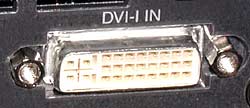 I’m presently working on a review of the InFocus ScreenPlay 5700 projector — a widescreen model aimed squarely at the PAL market since it uses Texas Instruments’ 1,024 by 576 pixel ‘Matterhorn’ DMD — for Best Buys. And nice as it seems to be, I’ve run into a problem. My expensive DVI cable doesn’t fit! You see, I also have the new Marantz DV-8400 everything player which has a DVI output with HDCP support. Unlike many, the ScreenPlay 5700 has HDCP support on its ‘DVI’ input. The problem is that it is not a DVI input as such, but a VESA M1 input (InFocus’ name for this is M1-DA).
I’m presently working on a review of the InFocus ScreenPlay 5700 projector — a widescreen model aimed squarely at the PAL market since it uses Texas Instruments’ 1,024 by 576 pixel ‘Matterhorn’ DMD — for Best Buys. And nice as it seems to be, I’ve run into a problem. My expensive DVI cable doesn’t fit! You see, I also have the new Marantz DV-8400 everything player which has a DVI output with HDCP support. Unlike many, the ScreenPlay 5700 has HDCP support on its ‘DVI’ input. The problem is that it is not a DVI input as such, but a VESA M1 input (InFocus’ name for this is M1-DA).
What’s the difference?
DVI (for Digital Video Interface) is fairly versatile. The type you are likely to see is that actually on the Marantz DVD player. Note that it is labelled ‘DVI-D Out (HDCP)’. What that means is that this socket is for output only, that it provides a digital signal only (the ‘D’ on the end stands for Digital) and that it uses the HDCP standard to encrypt the output to resist casual digital copying. Notice also the lonely horizontal slot on the right. This is a marker of a digital only connector.
 But the DVI socket can also be implemented as DVI-I, which stands for Digital Video Interface – Integrated. A DVI-I socket can be fed with either a DVI-D (Digital) signal or a DVI-A (Analogue) signal. See the next picture. This is of the DVI socket on an NEC WT600 projector. The giveaway here is that instead of that lonely horizontal slot it has a cross, surrounded by four more pin holes. These four holes accept an analogue signal. This is really just a convenience to provide an additional computer input socket. Note that a DVI-D plug can be connected to a DVI-I socket and it works just fine. As it happens, the NEC projector does not support HDCP so the Marantz DVD player would not deliver a usable digital video signal.
But the DVI socket can also be implemented as DVI-I, which stands for Digital Video Interface – Integrated. A DVI-I socket can be fed with either a DVI-D (Digital) signal or a DVI-A (Analogue) signal. See the next picture. This is of the DVI socket on an NEC WT600 projector. The giveaway here is that instead of that lonely horizontal slot it has a cross, surrounded by four more pin holes. These four holes accept an analogue signal. This is really just a convenience to provide an additional computer input socket. Note that a DVI-D plug can be connected to a DVI-I socket and it works just fine. As it happens, the NEC projector does not support HDCP so the Marantz DVD player would not deliver a usable digital video signal.
Now it seems that the DVI standards specify all manner of electrical stuff, but are a bit open with regard to the physical connections. InFocus got in early in the specification game and prompted VESA (Video Electronics Standards Association) to promulgate a different standard plug and socket for this purpose. This is called ‘M1’. See the third picture, which shows the socket on the aforementioned ScreenPlay projector. While it looks fairly similar to a DVI-I socket, it is substantially different. The M1 is a 30 + 4 pin connector, compared to 24 + 4 for DVI-I. It apparently provides power for line boosters, a USB connection and full plug and play compatibility, unlike DVI. This is all nice. InFocus says that M1 is only used as an input, so the connection is always DVI output to M1 input. Also, physically, the DVI and M1 sockets are incompatible. The M1 socket is 27.6mm long while the DVI socket is only 24.9mm long. Both are around 7.6mm wide. (My measurements.)
 I can see how these additional features of M1 could be useful. Except that there’s one huge problem: getting a DVI to M1 cable! I bought a DVI-D to DVI-D cable a few weeks ago (nearly $AUS50). To get it, I had to go to shop that specialises in computer cables. There I had a choice of, well, just one length.
I can see how these additional features of M1 could be useful. Except that there’s one huge problem: getting a DVI to M1 cable! I bought a DVI-D to DVI-D cable a few weeks ago (nearly $AUS50). To get it, I had to go to shop that specialises in computer cables. There I had a choice of, well, just one length.
Believe me, they did not have a DVI to M1 cable. Who does? InFocus has one, if you’re prepared to page through the list of 130 different cables it offers! This is a ten metre job and costs $US59.
I think InFocus had better re-consider. At least for it’s home theatre oriented projectors, it should offer them with standard DVI-I or DVI-D inputs, not M1.
UPDATE (Tuesday, 11 November 2003, 11:03 am): The Australian distributor of ScreenPlay projectors, International Dynamics, tells me that they have the DVI-D to M1 lead available, in stock, for $AUS99. They’ll send one up so I’ll be able to see how it works.
On reflection, I may have been a bit harsh on ScreenPlay. While I think there’d be more flexibility in cable selections if one could use DVI to DVI, the ready availability of their lead resolves much of the problem. If you’re buying an ScreenPlay projector with an M1 input, may I suggest you add the lead as part of your purchase. You may not need it yet but it’d be nice to have when you upgrade your DVD player. Chances are that within two or three years DVI outputs will migrate from being available only on high-end players, to mid-range players, to budget models, just as progressive scan output has largely spread throughout the range.
